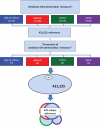Prevention of antibiotic resistance - an epidemiological scoping review to identify research categories and knowledge gaps
- PMID: 32475304
- PMCID: PMC7782542
- DOI: 10.1080/16549716.2020.1756191
Prevention of antibiotic resistance - an epidemiological scoping review to identify research categories and knowledge gaps
Abstract
Background: Antibiotics have become the cornerstone for the treatment of infectious diseases and contributed significantly to the dramatic global health development during the last 70 years. Millions of people now survive what were previously life-threatening infections. But antibiotics are finite resources and misuse has led to antibiotic resistance and reduced efficacy within just a few years of introduction of each new antibiotic. The World Health Organization rates antibiotic resistance as a 'global security threat' impacting on global health, food security and development and as important as terrorism and climate change.
Objectives: This paper explores, through a scoping review of the literature published during the past 20 years, the magnitude of peer-reviewed and grey literature that addresses antibiotic resistance and specifically the extent to which "prevention" has been at the core. The ultimate aim is to identify know-do gaps and strategies to prevent ABR.
Methods: The review covers four main data bases, Web of Science, Medline, Scopus and Ebsco searched for 2000-17. The broader research field "antibiotic OR antimicrobial resistance" gave 431,335 hits. Narrowing the search criteria to "Prevention of antibiotic OR antimicrobial resistance" resulted in 1062 remaining titles. Of these, 622 were unique titles. After screening of the 622 titles for relevance, 420 abstracts were read, and of these 282 papers were read in full. An additional 53 references were identified from these papers, and 64 published during 2018 and 2019 were also included. The final scoping review database thus consisted of 399 papers.
Results: A thematic structure emerged when categorizing articles in different subject areas, serving as a proxy for interest expressed from the research community. The research area has been an evolving one with about half of the 399 papers published during the past four years of the study period. Epidemiological modelling needs strengthening and there is a need for more and better surveillance systems, especially in lower- and middle-income countries. There is a wealth of information on the local and national uses and misuses of antibiotics. Educational and stewardship programmes basically lack evidence. Several studies address knowledge of the public and prescribers. The lessons for policy are conveyed in many alarming reports from national and international organizations.
Conclusions: Descriptive rather than theoretical ambitions have characterized the literature. If we want to better understand and explain the antibiotic situation from a behavioural perspective, the required approaches are lacking. A framework for an epidemiological causal web behind ABR is suggested and may serve to identify entry points for potential interventions.
Keywords: Antibiotic resistance; Antimicrobial Resistance; antimicrobial resistance; behaviour; drug resistance; global threat; health policy; prevention.
Conflict of interest statement
This report has been supported by the Foundation to Prevent Antibiotic Resistance and the author is a board member of the Foundation. Views and conclusions in the report are the author´s only and do not necessarily coincide with those of the Foundation.
Figures





Similar articles
-
Beyond the black stump: rapid reviews of health research issues affecting regional, rural and remote Australia.Med J Aust. 2020 Dec;213 Suppl 11:S3-S32.e1. doi: 10.5694/mja2.50881. Med J Aust. 2020. PMID: 33314144
-
What is the evidence base of used aggregated antibiotic resistance percentages to change empirical antibiotic treatment? A scoping review.Clin Microbiol Infect. 2022 Jul;28(7):928-935. doi: 10.1016/j.cmi.2021.12.003. Epub 2021 Dec 11. Clin Microbiol Infect. 2022. PMID: 34906718
-
Public sector reforms and their impact on the level of corruption: A systematic review.Campbell Syst Rev. 2021 May 24;17(2):e1173. doi: 10.1002/cl2.1173. eCollection 2021 Jun. Campbell Syst Rev. 2021. PMID: 37131927 Free PMC article. Review.
-
Public-targeted interventions addressing antimicrobial resistance and antibiotic use in Sub-Saharan Africa: a scoping review.BMJ Glob Health. 2025 Mar 21;10(3):e017455. doi: 10.1136/bmjgh-2024-017455. BMJ Glob Health. 2025. PMID: 40118465 Free PMC article.
-
How effective and cost-effective are behaviour change interventions in improving the prescription and use of antibiotics in low-income and middle-income countries? A protocol for a systematic review.BMJ Open. 2018 May 14;8(5):e021517. doi: 10.1136/bmjopen-2018-021517. BMJ Open. 2018. PMID: 29764887 Free PMC article.
Cited by
-
Trends in open tibia fracture antibiotic prophylaxis.Arch Orthop Trauma Surg. 2025 May 22;145(1):309. doi: 10.1007/s00402-025-05921-w. Arch Orthop Trauma Surg. 2025. PMID: 40402301
-
Multiple antibiotic resistance indexing and molecular identification of Escherichia coli isolated from clinical and nonclinical sources in Port Harcourt Metropolis, Nigeria.Pan Afr Med J. 2025 May 13;51:11. doi: 10.11604/pamj.2025.51.11.38524. eCollection 2025. Pan Afr Med J. 2025. PMID: 40727509 Free PMC article.
-
Hydrocinnamic Acid and Perillyl Alcohol Potentiate the Action of Antibiotics against Escherichia coli.Antibiotics (Basel). 2023 Feb 9;12(2):360. doi: 10.3390/antibiotics12020360. Antibiotics (Basel). 2023. PMID: 36830271 Free PMC article.
-
Antimicrobial photodynamic therapy against oral biofilm: influencing factors, mechanisms, and combined actions with other strategies.Front Microbiol. 2023 Jun 9;14:1192955. doi: 10.3389/fmicb.2023.1192955. eCollection 2023. Front Microbiol. 2023. PMID: 37362926 Free PMC article. Review.
-
The AMR emergency: multi-sector collaboration and collective global policy action is needed now.Glob Health Action. 2019 Dec 13;12(sup1):1855831. doi: 10.1080/16549716.2019.1855831. Glob Health Action. 2019. PMID: 33357144 Free PMC article. No abstract available.
References
-
- Van Puyvelde S, Deborggraeve S, Jacobs J. Why the antibiotic resistance crisis requires a one health approach. Lancet Infect Dis. 2018;18:132–133. - PubMed
Publication types
MeSH terms
Substances
LinkOut - more resources
Full Text Sources
Medical
Miscellaneous
